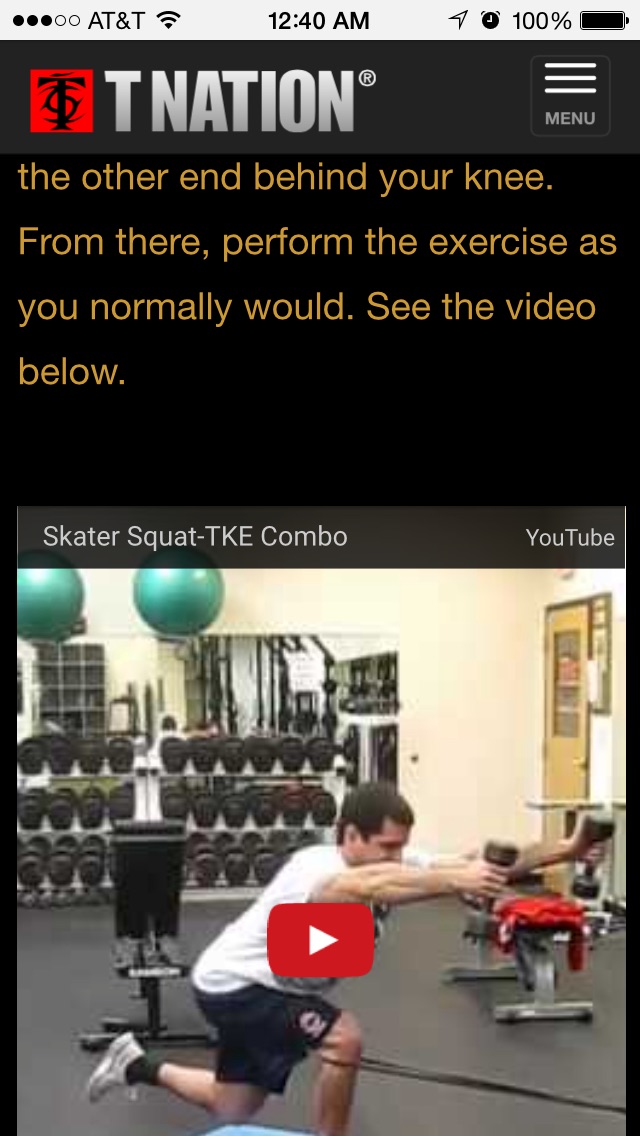What exercise is this guy describing, exactly?

tomatoey
Posts: 5,446 Member
There's mention of a video, but no video, in this article (which I found interesting)
https://www.t-nation.com/training/9-training-strategies-for-knee-pain
"For true single leg work like one-leg squats and skater squats, attach one end of a band to a sturdy post (a power rack works great) and loop the other end behind your knee (which knee, the standing leg or the other one? I've seen versions where the non-standing leg is banded, and then that knee is brought up in a knee-up after the standing leg does the squat). From there, perform the exercise as you normally would. See the video below.
no video
The band forces you to sit back to avoid being pulled forward, thereby loading the hips and taking stress off the knee at the bottom portion of the rep.
Here's the cool thing. As you come up, it shifts from a hip dominant movement pattern to a more quad dominant terminal knee extension (TKE), allowing you to strengthen the vastus medialis (VMO) within a more knee-friendly range of motion.
You can also do something similar to split stance work like split squats and Bulgarian split squats, only it's better to attach the band to a belt rather than putting it behind your knee just to make it easier to get into position.
Make sure to set up with a longer stride such that your tibia is perpendicular to the floor.
The band increases the demands on the quads because you have to continually push through your toes to grip the floor and maintain stability, but it does so within safe joint ranges because it's simultaneously driving you to sit back and maintain a vertical shin to keep from getting pulled forward."
I think it's probably the standing knee, make sense?
The article overall is pretty great imo
https://www.t-nation.com/training/9-training-strategies-for-knee-pain
"For true single leg work like one-leg squats and skater squats, attach one end of a band to a sturdy post (a power rack works great) and loop the other end behind your knee (which knee, the standing leg or the other one? I've seen versions where the non-standing leg is banded, and then that knee is brought up in a knee-up after the standing leg does the squat). From there, perform the exercise as you normally would. See the video below.
no video
The band forces you to sit back to avoid being pulled forward, thereby loading the hips and taking stress off the knee at the bottom portion of the rep.
Here's the cool thing. As you come up, it shifts from a hip dominant movement pattern to a more quad dominant terminal knee extension (TKE), allowing you to strengthen the vastus medialis (VMO) within a more knee-friendly range of motion.
You can also do something similar to split stance work like split squats and Bulgarian split squats, only it's better to attach the band to a belt rather than putting it behind your knee just to make it easier to get into position.
Make sure to set up with a longer stride such that your tibia is perpendicular to the floor.
The band increases the demands on the quads because you have to continually push through your toes to grip the floor and maintain stability, but it does so within safe joint ranges because it's simultaneously driving you to sit back and maintain a vertical shin to keep from getting pulled forward."
I think it's probably the standing knee, make sense?
The article overall is pretty great imo
0
Replies
-
It's the standing knee. I just watched the video. Do you have some kind of filter or ad blocker on or something?

0
This discussion has been closed.
Categories
- All Categories
- 1.4M Health, Wellness and Goals
- 398.2K Introduce Yourself
- 44.7K Getting Started
- 261K Health and Weight Loss
- 176.4K Food and Nutrition
- 47.7K Recipes
- 233K Fitness and Exercise
- 462 Sleep, Mindfulness and Overall Wellness
- 6.5K Goal: Maintaining Weight
- 8.7K Goal: Gaining Weight and Body Building
- 153.5K Motivation and Support
- 8.4K Challenges
- 1.4K Debate Club
- 96.5K Chit-Chat
- 2.6K Fun and Games
- 4.7K MyFitnessPal Information
- 17 News and Announcements
- 21 MyFitnessPal Academy
- 1.5K Feature Suggestions and Ideas
- 3.2K MyFitnessPal Tech Support Questions
